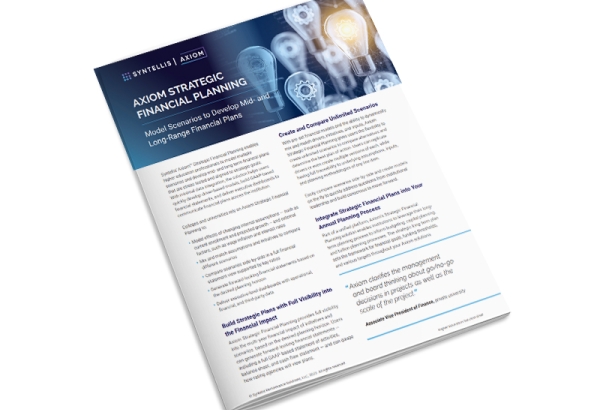The past ramifications of the pandemic and the future of an enrollment cliff collide, bearing a new question for universities today: How can leaders evolve and prepare their institutions concurrently?
Various factors in higher education stress the necessity of agility in decision-making: changing student demographics, funding uncertainty, and increasing competition. Leaders need to make financial decisions that will help their universities maintain a healthy financial position in the years ahead.
Leaders at Western Kentucky University (WKU) knew they needed to improve their strategic planning capabilities. As a public university with more than 16,000 students, five regional campuses, and five academic colleges, WKU finance leaders needed a new tool to better unite different functional areas and consider the long-term financial impact when making decisions. Axiom Strategic Financial Planning (SFP) quickly emerged as the solution that would help the university address today’s challenges by supporting data-driven decision-making and providing full visibility into the multi-year financial impact of initiatives and scenarios to devise long-range plans.
The need for data-driven decision-making
Leaders at WKU were struggling to make long-range decisions quickly — lacking accurate, timely data and dealing with a manual scenario modeling process. Decisions were made without considering the full impact on different functional areas over time, becoming especially prevalent when WKU needed to be agile with the changing higher education environment.
“The overarching challenge was that we needed to make better decisions, but we couldn't make data-driven decisions because of the difficulty of getting different types of data into one model and seeing the impact over multiple years,” said Renaldo Domoney, Assistant Vice President for Budget, Finance & Analytics at WKU.
Before WKU adopted SFP, decisions were based on anecdotal evidence. Leaders only responded to current implications, unable to see the long-term view.
“In the past, some of our decision-making was done at a micro level. For example, in a student financial aid model, we only looked at the implications that enrollment had on student financial aid. We did not have a straightforward way to consider the overall financial impact on the university.
“With SFP, we can see the financial outcome for the entire university. Now, when we look at enrollment, we can quickly and easily see the impact on tuition revenue and financial aid.” With SFP, his team also has visibility into enrollment’s impact on revenue for parking, dining, housing, and more — areas that were not easily considered prior to implementing Axiom.
Anticipating future financial impact with flexible modeling
With the adoption of SFP, WKU can now easily use scenario modeling to anticipate financial needs that may come down the line within the next ten years. With these data-driven insights, leaders across campuses are empowered to allocate resources more effectively to have a greater financial impact.
Currently, WKU finance leaders use SFP to model the impact of several factors, including staffing levels, salary increases, student financial aid, enrollment levels, tuition rate increases, and new initiatives (academic programs, partnerships with private sector, etc.). Modeling different scenarios helped leaders balance WKU’s short-term needs with long-term goals during planning
“Often, with a long-term plan, a new program might not make sense in the first year or two. But three to five years down the road, it's actually a financial gain. You won't get that insight without long-term planning,” Domoney said. “The long-term view of debt management, for example, clarifies where we can issue new debt to support different functions across campus that may not see a return right away.”
Offering more transparency into the decision-making process
In the past, leaders at WKU had a challenging time showing different scenarios, with the finance team building complex models manually in Excel.
SFP simplifies the modeling process, bringing all data together in one place and eliminating the need for manual work in offline spreadsheets. When WKU finance leaders present a financial plan, they can walk stakeholders through their decision-making process, toggling specific initiatives on and off to show the financial impact of each choice and compare the options to reach an end goal.
This level of transparency puts all stakeholders on the same page, enabling easier collaboration. The overall timeframe for budgeting is shorter, too, even with more people involved.
“We prioritize collaboration but also recognize it can slow down the process because you're getting different inputs and questions,” Domoney said. “SFP has sped up our ability to incorporate a variety of feedback and finalize a few scenarios that we think are appropriate for the university. What used to take three months now only takes three weeks with SFP.”
Relying on data to fuel decisions
“When we adopted SFP, I thought we would still update our system once per year like we did with our legacy systems. That’s not the case with SFP,” Domoney said. With the time saved, WKU has reallocated its resources to its long-term financial plan, updating it throughout the year as information becomes available instead of just once a year.
Gone are the days of drawn-out anecdotal decisions that considered the impact on a single department or line item. Today, WKU has the data needed to make better-informed decisions for the university and model different scenarios to determine the best path forward and ensure a sustainable future.
Learn more about Axiom Strategic Financial Planning

Axiom Strategic Financial Planning for Colleges and Universities

University of North Texas System Simplifies Budgets, Uses Data to Guide Decisions with Axiom Long-Range Planning



